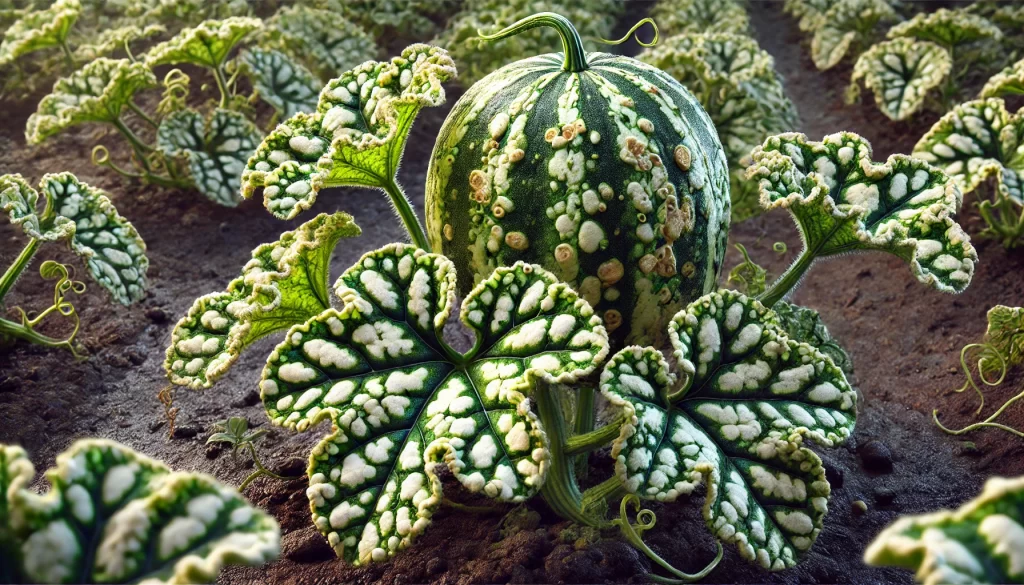The Mosaic Virus in melons is one of the most damaging viral diseases for this crop, affecting both fruit quality and yield. Early identification of this virus and adopting proper management strategies are essential to control its spread and minimize losses. In this article, we will explore how to recognize the symptoms of the Mosaic Virus in melons, its transmission mechanisms, and management practices to tackle it effectively.

Identification of Mosaic Virus in Melon
Visual Symptoms
The Mosaic Virus primarily manifests through changes in the appearance of leaves and fruits:
- Mottled leaves: An irregular pattern of yellow, green, and dark areas interspersed across the leaves.
- Leaf deformations: Twisted leaves with curled edges or stunted growth.
- Stunted growth: Infected plants often show reduced development and low vigor.
- Affected fruits: Melons may have mottled skin, deformities, and a reduction in flavor quality.

Transmission Mechanism
The virus spreads in several ways:
- Mechanical inoculation: Through contaminated pruning tools, hands, or machinery.
- Vectors: Some insects, such as aphids or mites, can transmit the virus by feeding on infected plants.
- Infected seeds: The virus can be present in seeds, transmitted to offspring.
Strategies to Manage the Mosaic Virus
Prevention
- Use certified plant material: Seeds and seedlings free of the virus are essential to prevent introducing mosaic into the crop.
- Garden hygiene: Disinfect tools and equipment, and practice crop rotation to reduce virus presence in the soil.
- Control of insect vectors: Implement integrated pest management measures to reduce the population of insects capable of transmitting the virus, such as using selective insecticides and biological control.

Early Detection and Monitoring
- Regular inspections: Conduct frequent field visits to detect early symptoms.
- Laboratory analysis: Confirm the presence of the virus through serological or molecular tests on suspect samples.
Management and Control
- Removal of infected plants: Immediately remove and destroy plants with clear symptoms of infection to prevent spread.
- Quarantine: Implement movement restrictions for potentially infected materials within and outside the field.
- Varietal resistance: When possible, select melon varieties that show resistance or tolerance to the Mosaic Virus.
- Education and training: Inform farmers about preventive management practices and the importance of field hygiene.

Integrated Strategies
Managing the Mosaic Virus requires a multidisciplinary approach:
- Integrated Pest and Disease Management (IPDM): A combination of cultural, biological, and chemical practices to prevent and control the disease.
- Community collaboration: Work with other farmers and agricultural extension organizations to share information on infection hotspots and successful strategies.
Conclusion
The Mosaic Virus in melon is a significant challenge that requires early detection, preventive management, and integrated practices to limit its impact. Adopting prevention measures, using certified plant material, controlling vectors, and removing infected plants are critical steps to mitigate the virus’s spread. With the right approach, farmers can protect their crops, maintain productivity, and ensure melon quality.
References
- Fauquet, C.M., & Mayo, M.A. (2004). “Virus Taxonomy: Classification and Nomenclature of Viruses – The 7th Report of the International Committee on Taxonomy of Viruses.” Academic Press.
- Pappu, H.R., et al. (2009). “The Mastrevirus Group: A Global Perspective on Distribution and Disease Impact.” Annual Review of Phytopathology, 47, 83-97.
- Hull, R. (2014). Plant Virology (5th ed.). Academic Press.
 AgronoBlog – Agriculture Blog
AgronoBlog – Agriculture Blog 


